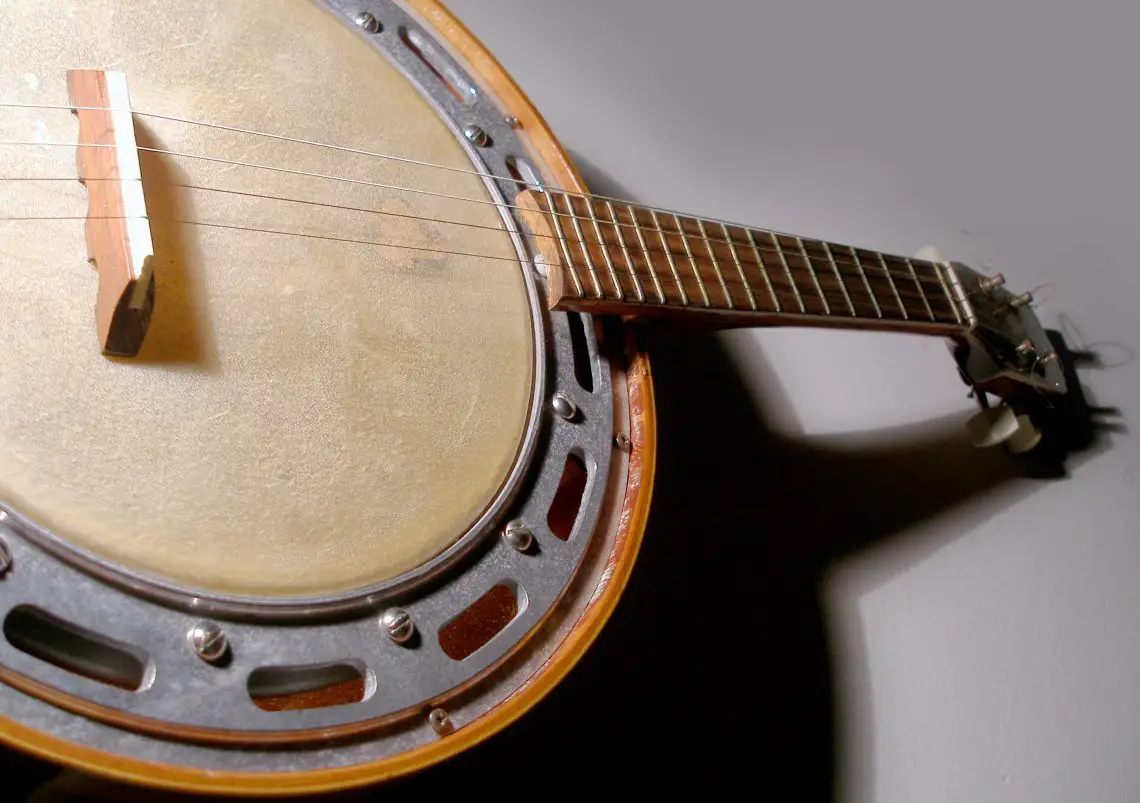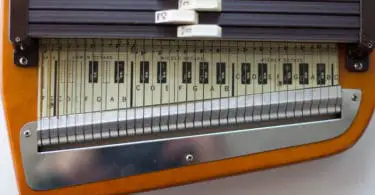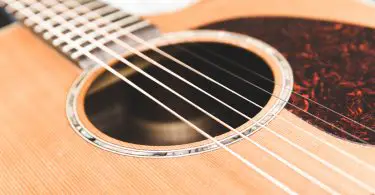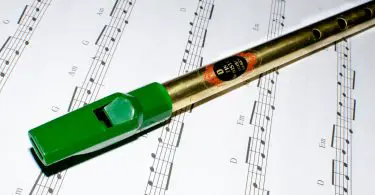The banjo is a popular instrument in country, folk, and bluegrass music. The first banjos were made of gourds with wooden sticks attached to form the neck. Joel Walker Sweeney made the instrument popular by using it in his Virginia minstrel act.
Many slaves taught their masters to play this instrument which added to the instrument’s popularity. My opinion on the best banjo is the mahogany Deering 5-Boston 5-string banjo that is extremely playable because of its ebony fingerboard. Keeping this instrument in tune is easy because it has guitar tuners. Its crown-style head means that all players can easily reach the pot to strum or pick it.
-
 $162.99Check on Amazon Check on eBay
$162.99Check on Amazon Check on eBay24 bracket with closed solid back and geared 5th tuner features a mahogany resonator allowing players to produce a very sweet sound.
06/29/2025 02:05 am GMT -
 Check on Musician's Friend Check on eBay
Check on Musician's Friend Check on eBayExtremely playable ebony fingerboard. Keeping this instrument in tune is easy with its guitar tuners. Its crown-style head puts the pot in easy reach.
-
 Check on Musician's Friend Check on eBay
Check on Musician's Friend Check on eBayFeatures a mahogany neck along with a mahogany resonator giving this banjo a sweet sound.
-
 Check on Amazon Check on Musician's Friend
Check on Amazon Check on Musician's FriendThe warm sounds produced by this banjo is the maple resonator showcasing a beautiful flame design.
-
 Check on Musician's Friend Check on eBay
Check on Musician's Friend Check on eBayHas a brass-cast tone ring that is attached in the Mastertone style enhancing the instrument’s volume.
-
-
 Check on Musician's Friend Check on eBay
Check on Musician's Friend Check on eBayThe bolt-on neck is constructed of maple enhancing the warm sounds that this banjo produces.
My father and uncles played in an old-time band with my father’s chosen instrument being the banjo. I grew up listening to beautiful music played on this instrument. My primary instruments are the piano and the cello and I was a music major at the University of Northern Iowa.
What Is the Best Beginner Banjo?
There are many decisions that the player needs to make to choose the best instrument for them. Understanding the different factors allows players to arrive at the best banjo for them.
But if you were to focus on one type as a beginner, we’d recommend a blue grass banjo. The banjo should have a resonator back with a wooden bridge.
Are banjos 4 or 5 strings? How many strings does a banjo have?
A banjo can have 4 strings, 5 strings, or 6 strings, with 5 strings being the most popular. The most popular type of banjo is the standard banjo which is also called the standard banjo. One of the reasons that this instrument is so popular is that players can use it to create a wide variety of music including country, gospel, jazz, folk, rock and classical.
Another reason that this instrument is so popular is that it is easy to find instructional material for it. These instruments are usually tuned to open G for bluegrass music. Some players of folk music use instruments tuned to open C.
After careful searching, we have arrived at our top recommendations and some other instruments that are worth considering. Included are a variety of instruments and price points so that everyone can find a banjo that meets their needs.
Jameson 5-string Banjo
24 bracket with closed solid back and geared 5th tuner features a mahogany resonator allowing players to produce a very sweet sound.
Players who are looking for a banjo on a budget need to consider the Jameson 5-string banjo. This banjo features a mahogany resonator allowing players to produce a very sweet sound.
Unlike more expensive banjos, the shell of this banjo is made from seven layers of maple and mahogany wood. The high-gloss finish makes this a beautiful instrument, however, it may soften the tone slightly.

Credit: R. W. Jameson Guitar Company
Twenty-four brackets hold the resonator in place helping to provide an airtight body where the sound can resonate while offering players the opportunity to remove the brackets to play in open-back style. A medium-sized head makes this instrument easy to play.
The strings vibrate properly because this instrument features an adjustable-hinged tailpiece. Raising the tailpiece a little gives this banjo a more traditional sound. A maple bridge gives this instrument a beautiful warm sound that players love.
Deering 5-Boston 5-string Banjo
Extremely playable ebony fingerboard. Keeping this instrument in tune is easy with its guitar tuners. Its crown-style head puts the pot in easy reach.
The Deering 5-Boston 5-String Banjo is our top recommendation because of its loud volume and its easy playability. The mahogany neck contains 22 frets separated with nickel-silver frets making it easy for players to play a variety of music.
While mahogany gives this neck incredible strength, the neck is slender making this instrument easy for smaller hands to play. Every other fret has a pearloid inlay surrounded by a seed and vine design, so players can easily keep track of where their fingers are on the neck.

Credit: DEERING® BANJO COMPANY
This instrument has an ebony fingerboard allowing players to play at a faster rate. Guitar tuners are standard on this banjo although planetary tuners can be special ordered. The neck and fingerboard have a satin finish adding to the beauty of this instrument.
Also adding to this instrument’s beauty is nickel-plated hardware. This instrument has an 11-inch high crown head allowing players to reach it easily rather they want to strum or pick the head. It also has a nickel-plated 3/16 inch steel rim.
The pot contains 24 flat hooks with 9/32 inch hex nuts. The flat hooks help to hold the pot tight while being unlikely to get caught on the player’s clothes. Players who want to play this banjo with an open back can easily remove the hex nuts.
This Deering banjo contains a mahogany resonator trimmed in white helping this instrument produce a loud sweet sound. It has five strings of medium weight. Deering strings are known by many banjo players for being extremely reliable.
This banjo has straight sidewalls. Like the neck, the resonator has a beautiful satin finish. This Boston banjo weighs about 9.5 pounds making it easy for most people to carry the weight for a long time.
Players love this instrument for its crisp highs and very responsive lows. This instrument’s crispness makes it a great choice for recording. Measuring just 38 inches, this banjo is easy to transport. Buyers can find the Deering 5-Boston banjo at Musician’s Friend for about $1,575.
Gold Star GF-100W Banjo
Features a mahogany neck along with a mahogany resonator giving this banjo a sweet sound.
For over 25 years, the Gold Star GF-100 was considered the best banjo for bluegrass music, and this banjo harkens to that grand tradition. This banjo features a mahogany neck along with a mahogany resonator giving this banjo a sweet sound.
This banjo contains inlaid double concentric rings helping to protect the instrument if it is hit. A cast bell-bronze tone rings adds sound clarity and a broad range of harmonics while enhancing this instrument’s ability to sustain notes.

Credit: Musician’s Friend
Helping enhance this instrument’s bright sound is a three-ply maple rim. This Gold Star banjo features an ebony fingerboard with nickel-silver frets making it easy to finger this banjo.
Hand-cut mother-of-pearl dots arranged in a wreath pattern on the fretboard adds to this banjo’s beauty, while allowing players to easily keep track of their finger position.
Tuning is easy because of the planetary tuners. Helping to hold the strings in place is a Presto tailpiece that not only helps to keep the strings taunt, but also helps to prevent extraneous sounds from the strings.
Adding to the brightness of this well-balanced instrument is a maple bridge. This banjo was available on Musician’s Friend for about $1,175 at time of review.
Washburn B17 Banjo
The warm sounds produced by this banjo is the maple resonator showcasing a beautiful flame design.
If you enjoy picking a guitar in country music style, then make sure to consider the Washburn B17 banjo. This five-string guitar features flat-head construction allowing players to easily play sweet gentle passages.
This instrument has a brass tone ring giving this banjo its beautiful warm tones. Also, adding to the warm sounds produced by this banjo is the maple resonator showcasing a beautiful flame design.

Credit: Washburn Guitars
The resonator is held on by 24 tension brackets allowing players to quickly remove it if they choose to play an open-back instrument. Also, enhancing the warm sounds produced by this banjo it has a maple neck.
Gold hardware also helps to enhance the beauty of this instrument. A tension tailpiece adds to the traditional look of this banjo while helping to eliminate string noise. This instrument is available on Musician’s Friend for about $1,700.
King Madison RK-R36 Banjo
Has a brass-cast tone ring that is attached in the Mastertone style enhancing the instrument’s volume.
This instrument is unique because it comes to the player ready to play because it is set up by an expert in the United States. The King Madison RK-R36 banjo features a mahogany resonator giving the instrument its beautiful sweet sound.
It may, however, be slightly slow to respond. The banjo’s fretboard is rosewood. This banjo has a brass-cast tone ring that is attached in the Mastertone style enhancing the instrument’s volume.

Credit: Recording King
King Madison has also chosen a one-piece banjo flange for this instrument. Players can be sure that the resonator will stay in place because of the well-constructed one-piece banjo flange. Enhancing the quality of this instrument is a three-ply steam bent maple rim.
This instrument would have placed higher if the mahogany wood was a higher quality than select, so it is not as fine-grained and may not be properly aged. Therefore, players need to be sure to keep this instrument in a stable temperature environment to protect it.
Of course, the tradeoff is that the company has been able to pass its lower costs on to the customer. The King Madison RK-R36 banjo was available on Musician’s Friend for about $1,550 at time of review.
Gold Tone EBM Electric Banjo
Has a humbucker beneath its head to enhance the sound.
If you are shopping for an electric banjo, then make sure to consider the Gold Tone EBM. This banjo weighing 8 pounds 5 ounces looks like a F-style mandolin. This instrument has
This instrument has beautiful gold hardware. Helping carry the sound, it has a single-coil pickup at the neck which air easily passes across. This banjo also has a humbucker beneath its head to enhance the sound.

Credit: Gold Tone Music Group
Helping ensure that this instrument stands up to playing many gigs, it has full-binding around its body, neck and head. This instrument has an 8 inch high-collar head allowing players to easily reach the strings rather they choose to strum or pick this banjo.
Also, helping players pick this banjo, the nut is 1 3/16 inch high. This instrument would have placed higher if it had an ebony fretboard instead of a rosewood as this makes the instrument harder to finger with the left hand.
Helping players make sure that their left hand is in the right position is a beautiful snowflake design that can easily be felt. The Gold Tone EBM electric banjo was available on Musician’s Friend for about $1,300 at time of review.
Dean GS B6 TSB Gran Sport Banjo
The bolt-on neck is constructed of maple enhancing the warm sounds that this banjo produces.
Those players who have been playing a guitar and considering adding a six-string banjo to their repertoire need to consider the Dean GS B6 TSB Gran Sport banjo.
This beautiful instrument features a mahogany top and body accented with chrome hardware. Helping ensure that the instrument’s sound carries beautifully, this instrument has a pickup on its neck and a humbucker on its bridge.
The bolt-on neck is constructed of maple enhancing the warm sounds that this banjo produces. Helping to protect the neck is an inlaid single-ply white binding.
This banjo would have placed higher, except that it has a rosewood fingerboard that is harder to finger than an ebony fingerboard. Players with smaller hands will find this instrument easy to play because of the small neck radius.
Parlor
Parlor banjos are shorter than regular banjos making them easier for children to play. Most are still tuned to open G, although some are tuned to open A. These banjos have 19 frets. These banjos are often called tenor banjos. They are particularly popular with players of Celtic music.
Long-Neck
As the name suggests, long-neck banjos have 25 frets. It was these instruments that Kingston Trio made popular. Musicians can create a variety of music on these instruments that are normally tuned to E.
Four-String
A variety of four-string banjos are very popular in Dixieland and Irish music. Some jazz banjo players also prefer these instruments because players find them easier to play quickly. Like the five-string banjo, these instruments come with 17, 19 and 22 frets.
Six-String
Taylor Swift, Keith Urban and John Fogerty have popularized the six-string banjo. It is easy to transfer skills learned on the guitar to these instruments making them a great option for players who would like to cross over to a new instrument.
12-String
These instruments produce a lacy tone, unlike the normal banjo sound. These instruments are the most difficult to play for most people.
Other Banjo Features
Resonator or Open Back
Players can find a back on a banjo similar to a resonator guitar or they can choose a banjo with no back at all. Banjos with a resonator back are louder because the sound vibrates off the back.
The back is normally attached by a couple of screws, so players can take the screws out allowing them to play without a back if desired. The sound from an open-back banjo is usually mellower than from a resonator banjo.
Tone Ring
One of the biggest difference between banjos is the tone ring which is positioned above the rim and below the head. A simple rolled brass tone ring produces a warm tone. Wooden tone rings produce a mellow sound with more projection.
Some instruments have both producing a very clear sound. Instruments where tone ring sits on top of a square tube produce a longer sustain and have very good projection. Mastertone rings produce a very bright sound.
Planetary or Guitar Tuners
Different banjos have different types of tuners. The first banjos had friction tuners although most new instruments have either planetary or guitar tuners.
Players will continue to argue which one is best. Many like planetary tuners because they feel they have a more traditional look and hold the strings in tune longer.
Others argue that guitar tuners are better because they have a higher ratio making it easier to fine-tune the instrument. Regardless of the type, the lower the gear ratio, the more turns required to tune the instrument.
Tailpieces
The best tailpieces are adjustable allowing players to easily tweak the sound of the banjo. They should also be vibration-resistant so that they do not cause extraneous instrument noise.
Banjo Woods
One of the most important buying decisions that players need to make is the wood for their instrument because different woods produce a different sound.
Mahogany
Mahogany banjos produce a sweeter sound although these banjos are slow to respond.
Maple
Maple banjos produces a bright sound especially when plucked. Since the wood absorbs very little energy, banjos with a maple neck produce a louder sound.
Some of the most sought after banjos are made with maple wood containing cross-grain stripes often called tiger stripes. This wood is the most traditional choice in America for banjos because of its availability, strength, grain and workability.
Walnut
Players who are looking for the middle ground need to consider a walnut banjo. These instruments produce more brightness than mahogany instruments and more warmth than maple.
Laminate or Solid-Block
Most players find that solid-block banjos are higher quality than laminated banjos because they produce a better sound. When layers of wood are put together with glue, the sound becomes muffled.
If you are opting for a laminate banjo because of cost, look for a banjo with staggered wood because there is less or no glue used in making these instruments.










Start the discussion at talk.hearthemusicplay.com